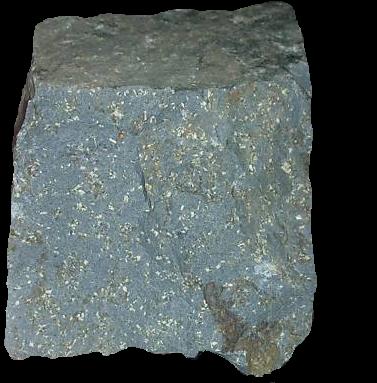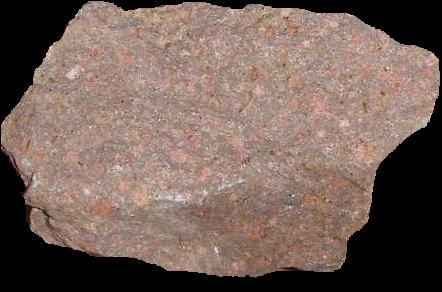Trachyfelsite

Trachyte is an igneous, volcanic rock with an aphanitic to porphyritic texture. The mineral assemblage consists of essential alkali feldspar; relatively minor plagioclase and quartz or a feldspathoid such as nepheline may also be present. Chemically, trachyte contains less silica than rhyolite and more (Na2O plus K2O) than dacite. Trachytes are often described as being the volcanic equivalents of the plutonic syenites. Their dominant mineral, sanidine feldspar, very commonly occurs in two generations, i.e. both as large well-shaped porphyritic crystals and in smaller imperfect rods or laths forming a finely crystalline groundmass. Quartz is typically rare in trachyte, but tridymite (which likewise consists of silica) is by no means uncommon. Of the mafic minerals present, augite is the most common. It is usually of pale green color, and its small crystals are often very perfect in form. Brown hornblende and biotite occur also, and are usually surrounded by black corrosion borders composed of magnetite and pyroxene. Sometimes the replacement is complete and no hornblende or biotite is left, though the outlines of the cluster of magnetite and augite may clearly indicate from which of these minerals it was derived. Olivine is unusual, though found in some trachytes. Apatite, zircon and magnetite are practically always present as accessory minerals. The trachytes necessarily contain considerable amounts of alkali. As such they approach phonolite. Occasionally minerals of the feldspathoid group, such as nepheline, sodalite and leucite, occur, and rocks of this kind are known as phonolitic trachytes. Trachytic rocks are typically porphyritic. In many trachytes, the phenocrysts are few and small, and the groundmass comparatively coarse. Ferromagnesian minerals rarely occur in large crystals, and are usually not conspicuous in hand specimens of these rocks. Two types of groundmass are generally recognized: the trachytic, composed mainly of long, narrow, subparallel rods of sanidine, and the orthophyric, consisting of small, squarish or rectangular prisms of the same mineral. Sometimes granular augite or spongy riebeckite occurs in the groundmass, but as a rule this part of the rock is highly feldspathic. Glassy forms of trachyte (obsidian) occur, as in Iceland, and pumiceous varieties are known. Felsite is a very fine grained volcanic rock that may or may not contain larger crystals. Felsite is a field term for a light colored rock that typically requires petrographic examination or chemical analysis for more precise definition. Color is generally white through light gray, or red to tan and may include any color except dark gray, green or black. The mass of the rock consists of a fine-grained matrix of felsic materials, particularly quartz, sodium and potassium feldspar, and may be termed a quartz felsite or quartz porphyry if the quartz phenocrysts are present. It is typically of volcanic origin, and may be found in association with obsidian and rhyolite.
Photographed by Michael P. Klimetz
SCOTLAND

Photographed by Michael P. Klimetz
Domite
[Trachyte]
Puy de Dome
Clerzon
Auvergne
FRANCE
Photographed by Michael P. Klimetz
Domite
[Trachyte]
Puy de Dome
Clerzon
Auvergne
FRANCE
Photographed by Michael P. Klimetz
[Trachyte]
COLORADO

Photographed by Michael P. Klimetz
Porphyritic Trachyte
[Sanidine Phenocrysts]
Drachenfels
Koenigswinter
Siebengebirge
North Rhine-Westphalia
GERMANY